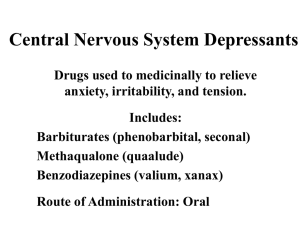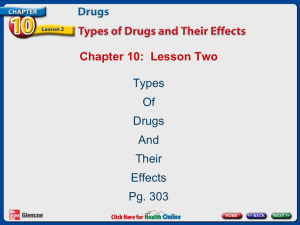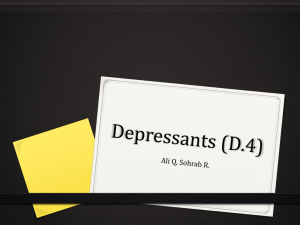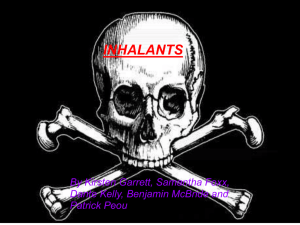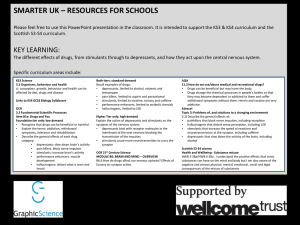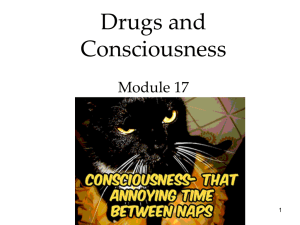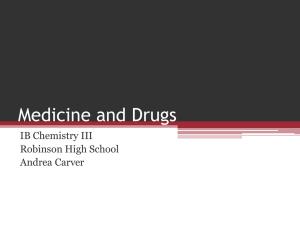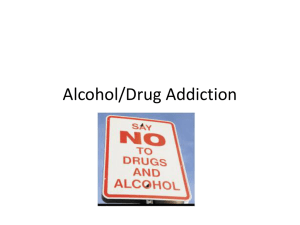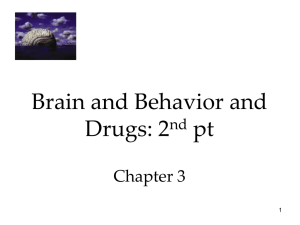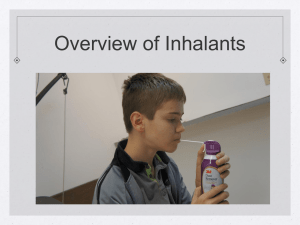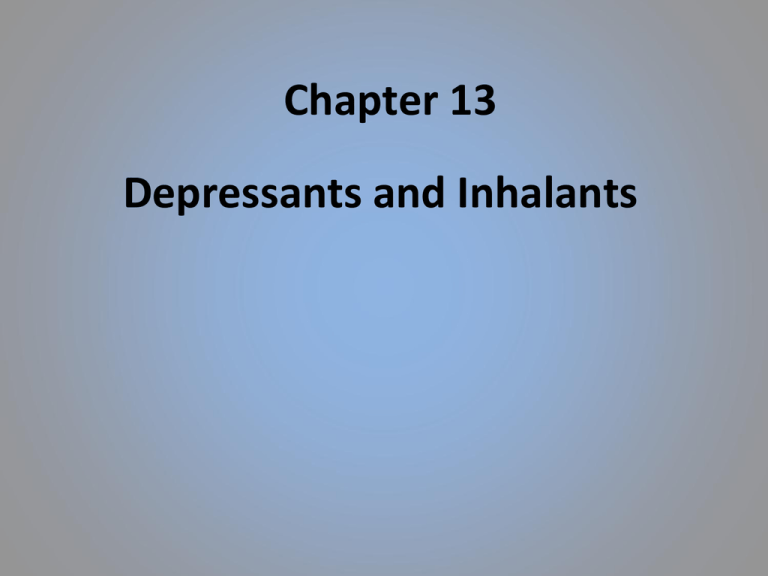
Chapter 13
Depressants and Inhalants
Depressants and Inhalants
Depressants
Barbiturates (major tranquilizers)
“sleeping pills” and anesthetics
Other sedatives
methaqualone and chloral hydrate
Benzodiazepines (minor tranquilizers)
anxiolytics
Contemporary sleep aids
β-blockers
GHB (γ-hydroxybutyrate)
“date rape” drug
Depressants and Inhalants
Inhalants
Nitrous oxide (N2O)
analgesic, “laughing gas”
Glue, solvents and propellants
Depressants and Inhalants
Introduced in 1903 and in use until approximately
1960, the primary sedative-hypnotics (drugs that
produce sedation and sleep) belong to the
barbiturate family of drugs.
Depressants and Inhalants
Depressants
Barbiturates (major tranquilizers)
phenobarbital
epileptic seizures
long-acting
amobarbital (Amytal)
“truth serum”
intermediate-acting
pentobarbital (Nembutal), secobarbital (Seconal)
animal anesthesia, euthanasia
short-acting
Barbiturates (major tranquilizers)
A major disadvantage of barbiturates is the potential of a
lethal overdose, particularly when the barbiturate is
combined with other depressants such as alcohol.
In addition, barbiturate withdrawal symptoms are very
severe and require careful medical attention.
Barbiturates of very limited usefulness as sleeping agents
because the “sleep” produced is more akin to
unconsciousness than normal sleep.
there are also undesirable “hangovers” in the short
term
addictive and result in alcohol-like withdrawal
symptoms in the long term
Effects of barbiturates at increasing doses
forebrain
hindbrain
Which of the following is NOT a term that refers to
barbiturates in general?
A. idiot pills
B. soft balls
C. pink ladies
D. golf balls
E. goofers
Depressants and Inhalants
Depressants
Barbiturates
Avoid use with:
Alcohol
Chloramphenicol
Chlorpromazine
Cyclophosphamide
Cyclosporin
Digitoxin
Doxorubicin
Doxycycline
Methoxyflurane
Metronidazole
Quinine
Theophylline
Warfarin
Benzodiazepines
Antiepileptics
Antihistamines
Narcotic analgesics
Steroids
Antidepressants
Antihypertensives,
Anti-arrhythmics,
Depressants and Inhalants
Depressants
Other sedatives
methaqualone (Quaalude) and chloral hydrate
methaqualone proved to have a high potential for
abuse and has little clinical usefulness (insomnia)
and is now a Schedule I drug
chloral hydrate (“Mickey
Finn”)
insomnia, presurgical, dental sedative
pentobarbital + chloral hydrate = Equithesin®
Depressants and Inhalants
Depressants
Benzodiazepines
chlordiazepoxide (Librium)
diazepam (Valium)
used prior to surgery and
dental procedures for their
anxiolytic and amnesic
qualities
The Development of Antianxiety
Drugs
Benzodiazepines
efforts in the 1950s focused on developing an
anxiolytic that was not a general depressant (sedative).
Meprobamate (Miltown) was the first in 1955 for this
purpose, although its effects resulted more from its
sedative properties than from its ability to relieve
anxiety.
Librium (1960) and Valium (1963) (benzodiazepines)
were the first to selectively reduce anxiety
Sleep-inducing effects of benzodiazepines especially
subject to tolerance
Table 13.3
The greatest cross-tolerance and crossdependence develop between __________.
A. heroin and amphetamines
B. heroin and LSD
C. alcohol and cocaine
D. alcohol and barbiturates
E. benzodiazines and barbiturates
Taken alone, benzodiazepines are very safe drugs.
However, they can be dangerous when taken in
combination with alcohol.
Social problems related to benzodiazepine drugs during
the 1970s centered on the widespread misuse of the
drug.
Prescriptions were written too frequently and for
excessive dosages.
flunitrazepam (Rohypnol; “roofies”)
emerged as a date rape drug in the last decade
odorless, colorless and tasteless
synergistic effects with alcohol
amnesic properties
not approved for any medical use in the U.S.
Depressants and Inhalants
Depressants
Contemporary sleep aids
zolpidem (Ambien)
chemically unrelated to benzodiazepines
binds to only 1 of 3 benzodiazepine receptor subtypes
has short-lived sedative effects
addictive, sometimes abused with stimulants
eszopiclone (Lunesta)
chemically unrelated to benzodiazepines
binds to all 3 benzodiazepine receptor subtypes
has sedative effects similar to those of benzodiazepine
FDA’s list of sedative-hypnotics (sleep aids) that carry a risk
of sleep- driving, defined as driving while not fully awake
and with no memory of the event (blackout driving).
Ambien, Ambien CR(zolpidem tartrate)
Butisol sodium
Carbrital (pentobarbital and carbromal)
Dalmane (flurazepam hydrochloride)
Doral (quazepam)
Halcion (triazolam)
Lunesta (eszopiclone)
Placidyl (ethchlorvynol)
Prosom (estazolam)
Restoril (temazepam)
Rozerem (ramelteon)
Seconal (secobarbital sodium)
Sonata (zaleplon)
Warning issued by Sepracor as part
of the FDA approval for Lunesta
After taking LUNESTA, you may get up out of bed while
not being fully awake and do an activity that you do not
know you are doing. The next morning, you may not
remember that you did anything during the night.
You have a higher chance for doing these activities if you
drink alcohol or take other medicines that make you sleepy
with LUNESTA. Reported activities include:
driving a car ("sleep-driving“)
making and eating food
talking on the phone
having sex
sleep-walking
Call your doctor right away if you find out that you have
done any of the above activities after taking LUNESTA.
Activities that have been reported to occur while
sleeping after taking Lunesta include
A. having sex
B. driving a car
C. shopping naked at the mall
D. cooking and eating
E. making phone calls
Depressants and Inhalants
Depressants
buspirone (BuSpar)
chemically related to benzodiazepines
does not act at GABA receptors
little cross-tolerance with alcohol, other
depressants
not anti-convulsant or muscle relaxant
affinity for 5-HT1A receptors and some DA receptors
pharmacological actions complex
anxiolytic effects develop slowly (weeks)
does not have sedative effects
used for generalized anxiety disorder (GAD)
Depressants and Inhalants
Depressants
β-blockers
used to treat hypertension
block sympathetic β-adrenergic receptors of heart
useful for transient treatment for autonomic effects
of anxiety
The disadvantage in treating anxiety with buspirone is
that __________.
A. it shows cross-tolerance with alcohol
B. it shows cross-dependence with alcohol
C. it has very troublesome side effects
D. there is a long delay before anxiety is relieved
E. It is not very useful for GENERALIZED anxiety.
Depressants and Inhalants
Depressants
GHB (γ-hydroxybutyrate)
“date rape” drug—colorless, odorless, tasteless
binds to GABAB receptor subtype (GABA metabolite)
approved by FDA in 2002 for treatment of narcolepsy
now a Schedule I drug
also has anabolic (protein-building) effects
CNS and Behavioral effects of GHB:
euphoria; dissociation; drowsiness; nausea; headache;
disorientation; loss of coordination; memory loss
in combination with alcohol, produces unconsciousness
Depressants and Inhalants
Depressants
Barbiturates (major tranquilizers)
“sleeping pills” and anesthetics
Other sedatives
methaqualone and chloral hydrate
Benzodiazepines (minor tranquilizers)
anxiolytics
Contemporary sleep aids
β-blockers
GHB (γ-hydroxybutyrate)
“date rape” drug
Depressants and Inhalants
Inhalants
nitrous oxide (N2O)
analgesic, “laughing gas”
first investigated in 1798
a major recreational drug in the early 1800s
“laughing gas parties” in Great Britain
sometimes classified as a dissociative substance
N2O is still used recreationally (Whippets)
non-toxic, but can result in hypoxia leading to death
not addictive
clinical application is for routine dental anesthesia
complex pharmacology
euphoric effects may be due to NMDA receptor blockade
Depressants and Inhalants
Inhalants
ether
used as a substitute for alcohol during temperance
and prohibition movements
used as an anesthetic—first general anesthetic
discontinued as better, safer anesthetics discovered
used as automotive starter fluid
reports of ether dependence, but without withdrawal
tolerance, craving and complete loss of interest
in social contacts and other activities
Depressants and Inhalants
Inhalants
glues, solvents and propellants
easily obtained, cheap, legal, abuse easily disguised
often associated with adolescents (11-13 yrs), poor
most are very toxic
carcinogenic
liver damage
dangers of hypoxia, aspiration of vomit, heart failure
generally do not produce dependence or withdrawal
Gateway? (He huffed, then he puffed, then he did blow.)
Table 13.4

